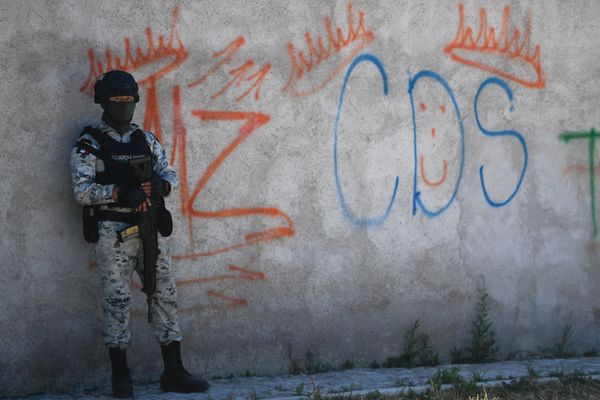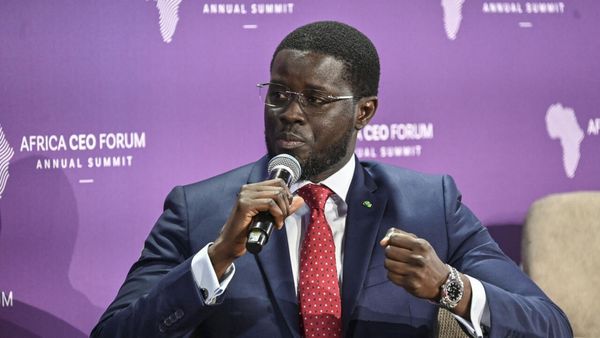
Driving from Agra to Gwalior, the beehad or ravines of Chambal become visible even before one approaches Morena, a district town in Madhya Pradesh. The undulating landscape, dotted with mud hillocks and thorny shrubs, spreads on both sides of the highway, the jungle cover thickening in the distance. From the highway, few signs of human settlement can be spotted in the ravines – a scattering of huts here and there and some temples along the road. “At one time the ravines of Chambal were home to many dacoit gangs. We were told stories about them as children. Today there are no dacoits in Chambal,” says the priest of one such temple along the Agra-Gwalior highway.
The last big police encounter with a dreaded dacoit – someone who could instil fear in the public – was 10 years ago, that of Rambabu Gadariya in 2007, says Umesh Joga, IG Chambal Zone, Madhya Pradesh. Smaller encounters have happened since. “Last year we killed another dacoit Bharosi Malla who had been absconding for many years. But he no longer had a full-time organised gang,” he explains.
Over the years, many dacoits have surrendered to the police. In 1960, for example, 20 dacoits are said to have surrendered after being persuaded by Vinoba Bhave. Then in 1972, Mohar Singh, another big dacoit of the time, surrendered with 100 men from his gang and many others from smaller gangs. “When Jayaprakash Narayan had told Indira Gandhi that he could arrange for the Chambal dacoits to surrender, she had said that she would negotiate terms of surrender only if I surrendered,” remembers Mohar Singh, with some pride.Other surrenders followed – Malkhan Singh and his gang in 1982, Balwant Singh Tomar, nephew of retired soldier and athlete-turned-dacoit Paan Singh Tomar, also in 1982, Phoolan Devi in 1983, Seema Parihar in 2000 and Renu Yadav in 2005, to name a few.

Having served prison time, these reformed bandits either live a life of retirement today, or are farmers, something that most of them were anyway engaged in before they took up arms. Like Phoolan Devi before her death, a few have also dabbled in politics, taken up a social cause or made television appearances, like Seema Parihar in the reality show Big Boss.
In an undated paper on Chambal dacoits available online, MZ Khan, at that time professor of criminology at the Institute of Criminology and Forensic Science, and DR Singh, then with the Bureau of Police Research and Development, write, “The offence of dacoity is by no means peculiar to any part of the country; yet in the (Chambal) valley it has certain features that set it apart from those perpetrated elsewhere. First, the permanent or semi-permanent structure of gangs made up of members firmly committed to dacoity in a professional way, is rather unique.”
As a section in the Indian Penal Code, robery committed by more than five people is dacoity, says Joga. But in popular perception, dacoit gangs are mostly those living in jungles, riding horses and armed with rifles.

Becoming Baaghis
The bandits of Chambal – the river flows through Madhya Pradesh, Uttar Pradesh and Rajasthan and the ravines are spread across the three states – were as feared as they were well known. Tales of their exploits circulated not just in the region in which they operated, but spread as far as Mumbai, where they inspired many Bollywood daku films, mainly in the 1960s and ’70s – remember Sholay and Ramgarh’s Gabbar Singh? But the real-life inspirations for these reel characters scoff at Bollywood’s portrayal of the bandits. “For one, we never came charging on horses like they showed in Bollywood films. We used to travel on foot,” says Mohar Singh. Over eighty now, dressed in a dhoti-kurta and Nehru jacket, Mohar Singh is the picture of a respected village elder. But he confides that he had 400 cases of murder registered against him when he surrendered.

The tag of a dacoit, even a former one, sits uneasily on Malkhan Singh, even 35 years after his surrender. “We weren’t dacoits. We were baaghis (rebels),” says the 74-year-old. Embittered by what he calls frequent misrepresentation of facts in the media, he is reluctant to share his story. “There were 100 bighas of land that was the property of a temple in the village. Some people in the village wanted to take over the land. When I protested, they started implicating me in all sorts of false cases,” he says. “I was harassed and became a baaghi.” Balwant Tomar also blames society and the system for creating outlaws. “There are three mains reasons for someone becoming a baaghi – one, the village pradhan, two, the area thanedar and three, the patwari of the area. If these people deliver justice, no one need become a baaghi,” he says. The uncle-nephew duo turned bandits after a property dispute with a section of the extended family turned violent and resulted in their killing two members of the other faction “in retaliation and self defence”. While Paan Singh was killed in a police encounter in 1981, Balwant surrendered in 1982. “Thirteen people of our gang had died in the encounter that killed my uncle. 10,000 police officers had us surrounded. The encounter continued for over 13 hours. I was the only one who escaped alive from there,” recalls Balwant.

Other former dacoits HT spoke to – Hari Singh Parmar, Munna Singh, Bahadur Singh – all spoke of similar disputes (often within the family) or harassment (by influential or rich people in the village or the panchayat and the authorities), as the reason for becoming dacoits.
“It was a rural economy. The only occupation was agriculture. There would be a lot of land-related disputes. When the dispute would get stuck in a revenue court or a civil court for a long time, people lost patience. In case of a fight, if a grievous crime took place, they would run away to the ravines,” agrees Joga.
Life In The Jungles
It wasn’t easy being a baaghi. “While crossing the river, we had to be careful of ghariyals. There was also a kind of thorny shrub, the sting of which was more dangerous than a bullet injury,” says Malkhan Singh. There were snakes, scorpions and wild animals to contend with. The bandits mostly lived in the open. “In the monsoons, we used to put up tarpaulin tents and take shelter under them,” says Munna Singh, also a former dacoit.

They would constantly be on the move to avoid detection. But the jungle also becomes home, says Tomar. “We hated the light. If we had to smoke, we would hide in our blankets and smoke. The cooking was done in the day. If we lit lights we would be identified. The people we kidnapped were made to work. Also, dacoit groups didn’t just have dacoits - there would be those who cooked, carried etc… There was no shortage of milk and ghee, we would get it from the villages,” he adds.
In the paper on the Chambal dacoits, MZ Khan and DR Singh observe, “Although for all practical purposes the bandits, while at large, forsake settled community life, they receive active popular support and supplies...” This support came not just in the form of provisions, but also help in evading arrest. It would also often extend to information about who could be a likely target for the dacoits to abduct.
The Principled Bandit
One reason for the villagers helping the bandits could be that the latter say that they never bothered the poor. “We would help the poor,” says Mohar Singh emphatically.
Things were, in fact, better then, feels Malkhan Singh. “No one dared harass a woman in my time. Even now when I hear of crimes committed against women, my blood boils. Dacoits have gone from Chambal, but has crime been checked?” he questions.
There is also a strong sense of regional superiority among the dacoits of Madhya Pradesh and Rajasthan. They look down upon those who operated in that part of Chambal which lies in Uttar Pradesh. “The gangs in Madhya Pradesh and Rajasthan never had women. The one exception is Putli Bai, who was Sultana daku’s partner. That was ages back. All the recent women dacoits such as Phoolan Devi and Seema Parihar… have been in Uttar Pradesh. Dacoits there, such as Nirbhay Gujjar, have been known to abduct women and keep them in their gangs,” says fity-five year old Hari Singh Parmar, another former dacoit who surrendered in 1996. Another example of a former UP-based woman dacoit is Renu Yadav, who was kidnapped by the late UP-based bandit Chandan Yadav and later forced to marry him and join his gang. After Chandan was killed by another bandit in 2005, Renu killed his murderer, and then surrendered in 2005.

Parmar, and indeed most former dacoits HT spoke to, remembers giving money to get girls in the village married off if their families didn’t have the funds for their marriage. “I must have gotten about 30 girls married,” says Parmar.
Also, the dacoits never operated in their own village or ilaka. But if they were indeed such do-gooders, what of the hundreds of murder cases that were registered against them? Joga scoffs at the idea of the dacoit “as some Robin Hood like character”. But Tomar explains, “If anyone gave the police information about us – worked as mukhbirs or informers – we had to teach them a lesson.” One of the biggest crimes that Tomar says he and his uncle committed was killing nine people of the Gujjar community in a village and setting the village ablaze, after one of them turned police informer and led to the death of Balwant’s father, Matadin Tomar, in a police encounter.
Parmar admits that he was a terror. In addition to killing people, he says he would “cut off people’s ears and noses if they didn’t pay ransom or became police informers”.
Old scores, the reason why they had become baghis in the first place, also needed to be settled.
For the most part though, the dacoits say they would concentrate on abductions for funds. Contrary to popular perception, there wasn’t much money in dacoity. Munna Singh says they usually got Rs 50,000 as ransom. “Once we got Rs 2 lakh,” he says. But dacoits who came a few years after him, such as Parmar, says they got as much as Rs 6 lakh at times. “Sometimes people would be kidnapped in Delhi and Ghaziabad and brought to us. We would be given a certain amount and they would keep the rest of the ransom money,” says Renu Yadav.

The modus operandi was simple. The dacoits dressed in police uniforms – right down to the caps and shoulder straps – to avoid detection. “We would go to the target’s house, ask for him and say he had to accompany us to the nearest thana for questioning. We had a warrant for him. As soon as we were out of the village, we would fire in the air and loudly raise a cheer for the gang leader. Someone from the village would hear this and inform the victim’s family about the abduction,” says Munna Singh. Often they carried better arms than the police, says Mohar Singh.
Interestingly, the dacoits not only dressed or armed themselves like the police, but even used official jargon with respect to their work. Most refer to the abduction process as going on a “vardat” or encounter. Perhaps in their minds they were a parallel system.
But where did they get the police uniforms? “Nothing is difficult to obtain when you have the money to pay for it. We had our suppliers. The political leaders themselves would often help us, even with arms,” says Parmar, who says he used a Carbon in those days. Others say they had AK 47s. “Before elections the leaders would contact us. Dacoits would also do the propaganda for the leaders,” he says.

Of course that doesn’t mean the dacoits did not live in fear every minute. “The day you became a baaghi you knew that you were living in the shadow of death every hour of the day,” says Balwant Singh. The cops would also keep a watch over the families of the dacoits and harass them for information of the outlaws. Once someone became a bandit, most of their families would leave their own villages and live elsewhere in hiding.
Balawnt Singh’s wife was at her parents’ place when he became a dacoit. The family was later shifted to the quarters of a cousin who was in the army, to protect them. “The day Paan Singh was killed in encounter, we were watching the news on television. I remember breaking down. I didn’t know whether my husband had survived. Even now when I think of those days I can’t hold back my tears,” she says. “
“At that time”, says Tomar, “I had never thought that I would someday return to live with my family like this”. There’s a tinge of wonder in his voice as he says this.
Life Post Surrender
Munna Singh seems to be making up for lost time as he sits surrounded by his neighbours and family in his village in Bhind district of Madhya Pradesh. “Sometimes I go to the local school and spend time with the children there,” he says. Most of the bandits who surrendered have spent eight years or more in prison before being released. But their time as dacoits and jailbirds doesn’t seem to have impacted their integration in society. On the way to meet Munna Singh, a local points out his house to us. When asked whether people are still afraid of the former dacoit, he laughs. “What’s there to be scared of? He is old, like a grandfather,” says the man. Malkhan Singh is fondly referred to as “Daddaji” by associates.
In the online paper on Chambal dacoits, MZ Khan and DR Singh write, “The offenders are proclaimed outlaws, but they are not socially regarded as fallen or depraved. Belonging to different caste-groups, they are seldom looked down upon for their grisly deeds. On the contrary, they may be bestowed honorifics like the ‘Baghi’, ‘Raja’, ‘Master” or ‘Thakur”.
Still, there are complaints. “The surrender package had included a job for one person from the family. But no one from my family was given a job. Even if one person gets a job it helps improve the living conditions of the entire family,” frets Munna Singh. Most of his brothers and nephews are farmers or work as contract workers.
Parmar on the other hand has been given the land promised to him to settle down, but says it is yet to be registered in his name. A bigger grouse for him is that the license for one rifle, which he says was promised to every surrendered dacoit for self-protection, is yet to be given to him. “A dacoit makes enemies. I live in fear for my and my family’s safety all the time. I worry that my sons might get embittered with this constant threat and take up arms and become a dacoit like I did,” he says.
Most of the former bandits say they don’t talk much about those days with their families for fear that they might feel inspired to follow in their footsteps. “That life has its charms – you have money, power, connections” says Tomar.
What then inspired the surrender? The replies are vague. The offer of a good surrender package, says one, while another dacoit says, “We had had our revenge.” Perhaps, it was just exhaustion with life on the run, though none of them admit it.
Whatever the reason, the era of the infamous Chambal dacoits seems to have passed. “Two things have made it difficult for that kind of dacoit gangs to flourish here now ,” says Joga. “Roads have been constructed into the villages.” This has made even remote areas accessible for the police, and hiding a challenge for the bandits. “Plus, everyone has mobile phones now, so it is easier for us to get information. We have also initiated many grievance redressal mechanisms to settle disputes quickly,” he adds.
A little outside Morena, as one crosses the bridge over the Chambal, groups of youngsters – men and women – can be seen taking the path down to the river, or sitting on its bank. A child plays on the edge of the beehad. The area looks like any other picnic spot. The brooding shadow of the jungle in the distance appears less threatening than the dark alleys of a city often do.







